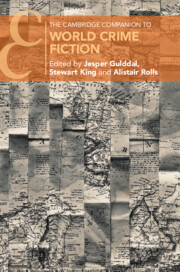Book contents
- The Cambridge Companion to World Crime Fiction
- The Cambridge Companion to World Crime Fiction
- Copyright page
- Contents
- Notes on Contributors
- Preface
- Chronology
- Chapter 1 What Is World Crime Fiction?
- Chapter 2 Crime Fiction and the International Publishing Industry
- Chapter 3 The Translation and Circulation of Crime Fiction
- Chapter 4 The International Crime Fiction Collection
- Chapter 5 Regional Crime Fiction
- Chapter 6 Women in World Crime Fiction
- Chapter 7 East Asian Crime Fiction
- Chapter 8 Crime Fiction in South Asia
- Chapter 9 Arab Crime Fiction
- Chapter 10 The Crime Fiction of Sub-Saharan Africa
- Chapter 11 European Crime Fiction
- Chapter 12 Scandinavian Crime Fiction
- Chapter 13 Iberian and Latin American Crime Fiction
- Chapter 14 World Crime Fiction in French
- Further Reading
- Index
- Cambridge Companions To …
Chapter 9 - Arab Crime Fiction
Published online by Cambridge University Press: 14 April 2022
- The Cambridge Companion to World Crime Fiction
- The Cambridge Companion to World Crime Fiction
- Copyright page
- Contents
- Notes on Contributors
- Preface
- Chronology
- Chapter 1 What Is World Crime Fiction?
- Chapter 2 Crime Fiction and the International Publishing Industry
- Chapter 3 The Translation and Circulation of Crime Fiction
- Chapter 4 The International Crime Fiction Collection
- Chapter 5 Regional Crime Fiction
- Chapter 6 Women in World Crime Fiction
- Chapter 7 East Asian Crime Fiction
- Chapter 8 Crime Fiction in South Asia
- Chapter 9 Arab Crime Fiction
- Chapter 10 The Crime Fiction of Sub-Saharan Africa
- Chapter 11 European Crime Fiction
- Chapter 12 Scandinavian Crime Fiction
- Chapter 13 Iberian and Latin American Crime Fiction
- Chapter 14 World Crime Fiction in French
- Further Reading
- Index
- Cambridge Companions To …
Summary
This chapter explores the history of crime writing in Arabic. It first traces the depiction of police and crime investigation in classical sources and then moves to the nineteenth century, when representations of crime and detection became an important part of the expansion of the press during the literary renaissance in the Arab world known as the Nahda. As a next step, the chapter turns to the early twentieth century, exploring the trope of the noble thief who has been unjustly oppressed by a corrupt justice system and police force. The chapter argues that this highly negative image of the police would continue throughout much of the twentieth century in Arabic literature, as seen in Naguib Mahfouz’s seminal 1961 novel, The Thief and the Dogs. The chapter then discusses two little-known works, the first police procedural written in Arabic from 1960s Morocco and a photo-novel from 1970s Lebanon, highlighting important developments in the depiction of crime and policing in Arabic. The chapter ends by tracing the development of the police procedural in North Africa, linking transformations in human rights in the region to the representation of policing in Arabic fiction.
Keywords
- Type
- Chapter
- Information
- The Cambridge Companion to World Crime Fiction , pp. 160 - 177Publisher: Cambridge University PressPrint publication year: 2022



